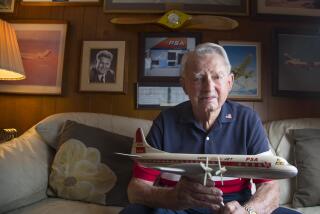USAir May Catch PSA’s Smile and Keep It : Ad and Painted Planes Have Lots of Flier Recognition, Survey Shows
- Share via
SAN DIEGO — When Jane Fonda scrambles to get out of town fast in “The Morning After,” a murder mystery movie that premieres on Christmas Day, she rushes to a Pacific Southwest Airlines ticket counter at Los Angeles International Airport.
PSA--which in real life carries about half of the 8 million passengers who travel the “California corridor” between Los Angeles and San Francisco each year--evidently comes through in the clutch for Fonda.
However, assuming USAir Group’s $400-million bid for PSA is successful--and if a future movie sequel requires a similarly quick trip back to LAX--Fonda could end up booking a seat on a USAir flight.
Despite early indications that USAir would wipe the famous “smiles” off PSA’s airliners to better match its own, more somberly painted fleet, USAir Chairman Edwin Colodny recently promised PSA employees that he will think “long and hard” before abandoning PSA’s self-proclaimed “smile that won the West.”
Marketing experts suggest that Colodny has reason to move cautiously before doing away with the smile that has been painted beneath the noses of PSA’s planes since 1969. PSA maintains that its “smileliners” were the product of an ad agency--not, as legend has it, the creation of a mischievous maintenance man with a paint brush.
A recent marketing study conducted for PSA suggested that only United Air Lines’ “Fly the Friendly Skies” slogan commands more recognition among West Coast travelers than PSA’s “Catch Our Smile.”
In that study, 55% of West Coast respondents correctly identified the PSA slogan. In Los Angeles, 72% of those responding made the association.
United’s “Friendly Skies” was correctly identified by 83% of West Coast respondents and by 81% of Angelenos.
That kind of consumer awareness contrasted with Alaska Air Lines’ “Fly With the Happy Face” slogan, which was correctly identified by only 5% of West Coast respondents in the PSA-sponsored survey. And, in a finding that brought smiles to PSA faces, 38% of the respondents thought that the “happy face” belonged to PSA.
USAir, which has not conducted a recent marketing survey in the West, is “extremely well known” in the eastern United States, according to spokesman David H. Shipley. He acknowledged that name recognition “drops off” in the West, where USAir has relatively few flights. USAir wants to “enhance that awareness,” Shipley said.
The airline successfully played the name-change game in 1974. It dropped the longtime designation Allegheny Airlines and became USAir, a name chosen because it seemed more likely to be perceived as that of a “big airline.” The new name also had the advantage of distancing the carrier from the unwanted “Agony Airlines” nickname that might still be buried in the minds of Easterners who since have migrated to California, one airline marketing expert said.
Marketing sources agree that the relatively unknown USAir might capitalize on PSA’s image as a well-established, low-cost, high-frequency flier that boasts a spanking new fleet.
PSA President Russell Ray believes Colodny should give serious thought to retaining the PSA name “because there’s a hell of a lot of equity tied up in that name.”
“I’d go very slowly if I were running the show at USAir,” said Arizona State University marketing Prof. Jeff Bracker, who suggested that it would be “a mistake to automatically change the name.”
But Jim Sowers, a University of Houston marketing professor who studies airline mergers, said: “The keys are price and service and, if USAir can provide them, then there’s no problem” with eliminating the PSA name, slogan and smile.
“Taking their time is the best thing they could do right now,” one marketing expert suggested. “You don’t want to push too hard on the travel agents or the public. It takes a long time to get the right feeling with a new name.”
More to Read
Inside the business of entertainment
The Wide Shot brings you news, analysis and insights on everything from streaming wars to production — and what it all means for the future.
You may occasionally receive promotional content from the Los Angeles Times.










